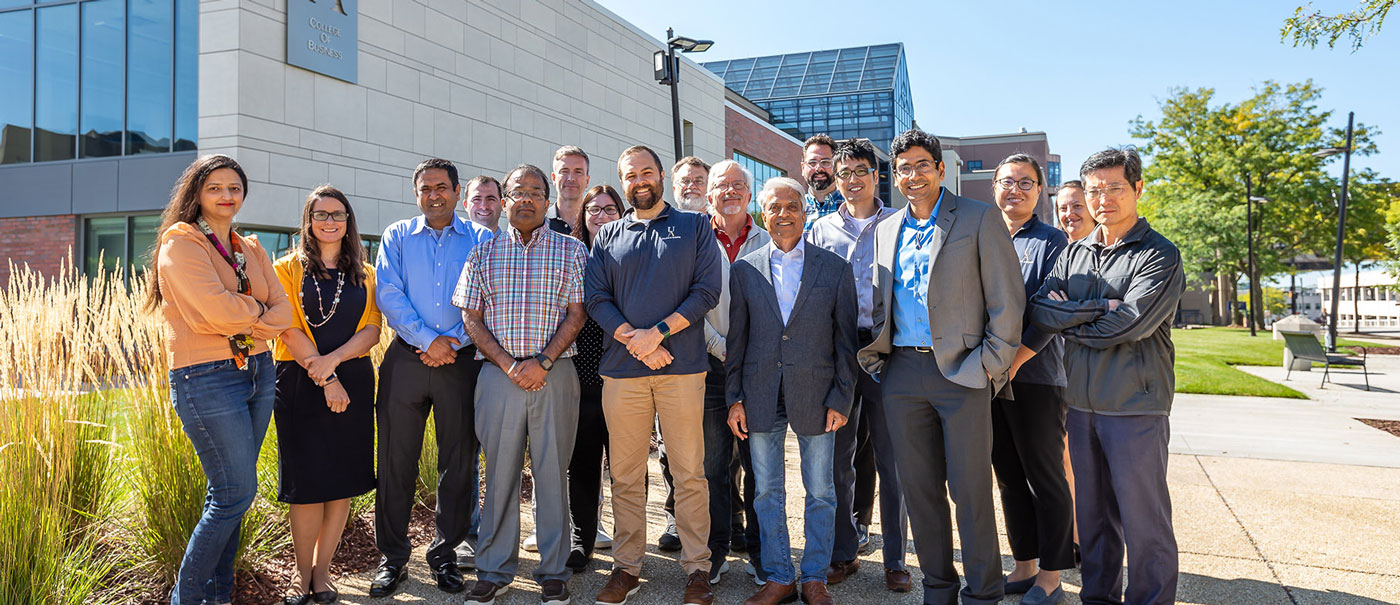
Faculty Research Highlights
The College of Business faculty are renowned for both their teaching and research. Students benefit from the real-world knowledge they bring with innovative, interactive and technology-based approaches.

Dr. Steven Ash - Using Predictors of Trust to Help Managers and Their Teams
Dr. Steven Ash’s research has helped bridge the gap between the two previously distinct paradigms of trust. One paradigm has two dimensions: cognition- and affect-based trust; and the other paradigm has four dimensions: ability, behavioral integrity, benevolence, and values congruence. Ash connects these paradigms and theorizes that the most important predictors of cognition-based trust are ability and behavioral integrity, whereas the most important predictors of affect-based trust are values congruence and benevolence. Though these are the most important predictors of the two dimensions in the first paradigm, it is important to note that all four trustworthiness factors - ability, behavioral integrity, benevolence, and values congruence - are related to both cognition- and affect-based trust.
Read MoreBy bridging the gap between the two previously distinct paradigms, Ash’s theory has practical implications for managers and their team members.
An understanding of the predictors of cognition- and affect-based trust can help managers successfully achieve desired outcomes for their teams. Specifically, Ash’s research can help managers navigate a variety of workplace challenges, such as creating healthy learning environments, generating team psychological safety, and building confidence in team members’ capabilities, amongst other types of obstacles.
Ash’s extensive knowledge and research on trustworthiness and trust, particularly the predictors of cognition- and affect-based trust and how the trustworthiness-trust relationship can influence the workplace, make him an integral member of the Department of Management within the College of Business here at the University of Akron.
Additional Researchers: Edward C. Tomlinson, Andrew K. Schnackenberg, David Dawley

Dr. Frederik Beuk - Emotions And Spillover Effects Of Social Networks
Social media, undoubtedly, can impact how people feel about their lives. The two experiments conducted in this study examine the emotional spillover that comes with social media. This is the idea that the ways in which social media makes us feel can overflow onto other sites that are not social network sites.
Read MoreThe first experiment was conducted online. Users were presented with two sites of executive teams. “Namely, the sites differed in the level to which the photographs are positively posed in various environments, which, as noted, is a dominant aspect of social networks (Beuk 6). These individuals had to decide how much they would want to work for or invest in the company. The test subjects also had to rate their social networks affective wellbeing and general tendency envy.
The results of the first experiment indicated the idea of emotional contagion as the subjects “are more inclined to work with and invest in a company when its executive team members exhibit a more positive emotional expression” (Beuk 9). Overall, the results supported the idea that when the design of a non-social media site is similar to the appearance of a social media site, then it will have the same ability to trigger the users’ emotions (10).
The second experimental study involved eye-tracking. Users were supposed to look at Facebook feeds for three minutes and then rate how much 36 descriptive words apply to them. This was then compared with the first study.
The results of the second experimental study found that “the more the emotional structure of the SNS triggering site is similar to that of an SNS site, the processing of the raised emotions is relevant for the negative results to emerge” (Beuk 13). Not to mention, the emotional structure is only relevant to the work-related decision and not the investment one (Beuk 14).
Overall, this study investigates the link between how users feel on other outlets and if the impact of social media continues to impact them.
Additional Researchers: Eran Rubin

Dr. Frederik Beuk - Social Networks, Emotions, and Investors: How They’re All Connected
Dr. Frederik Beuk, associate professor of marketing, has conducted extensive research on emotional processes related to social networks sites. Specifically, in his work, Beuk explores how a person’s perceptions of social networks site (SNS) experiences impact their decisions in a non-SNS. Through a series of experiments, Beuk established how individuals’ decisions in a non-SNS are affected by SNS emotions.
Read More
Dr. Sydney Chinchanachokchai - Cultural Differences In Gift Recipients’ Attitudes And Behaviors
Two studies were conducted to explore the behavior around bad gift-giving. The pretest to these studies included 69 undergraduate US students and 77 undergraduate Thailand students who filled out a questionnaire and wrote down information that described their experiences with gift-giving (Pusaksrikit 21). The results of the pretest showed what objects were considered a bad gift was one “hat violates the cultural norm and value” (Pusaksrikit 21).
Read MoreThe design of the study analyzed both collectivist culture and individualistic culture responses in conjunction with close and distant relationships (Pusaksrikit 22). The participants were divided up accordingly to test those factors and they needed to recollect their past gift giving experiences and then rate (based on a 7-point scale) “about their feelings of disappointment, the likelihood of returning the gift, retaliation, and the resources they would spend on reciprocity” (Pusaksrikit 23).
The results of the first study had compared Americans and Thais in their response to receiving a bad gift in close and distant relationships. The second study looked at the behavior tendencies in those who do not like the gifts they got and how they relate to their cultural backgrounds. “The recipients may use, keep, dispose, donate, or regift depending on their self-construal types” (Pusaksrikit 25). This study used a 7-point scale to determine the perceptions of 518 subjects. The second study also indicated how Thais and Americans differed in the way they regarded the disliked gift: use it, dispose of it, give it to charity, etc.
In both societies, gift-giving was important, but the reactions and behaviors afterwards can and have differed (Pusaksrikit 29).

Dr. Sydney Chinchanachokchai - Advertisements: Distractions Versus Consumer Memory
Dr. Sydney Chinchanachokchai’s research on consumer memory for ad content gives marketing professionals the opportunity to expand their understanding of consumer behavior, which can help them in developing effective advertising practices. More specifically, Chinchanachokchai’s research examines the impact of mind wandering and multitasking on consumer memory.
Read MoreMultitasking is considered an external distraction, meaning it emanates from outside sources, while mind wandering is considered an internal distraction, stemming from one’s own thoughts. Both of these types of distractions can impact the effectiveness of an advertisement and, through three experiments, Chinchanachokchai established the relationship between multitasking, mind wandering, and consumer memory for ad content.
Chinchanachokchai first sought to establish how memory is affected by mind wandering. She found that interesting advertisements resulted in less mind wandering and participants remembering more content than when listening to mundane ads. Moreover, mind wandering occurred more during the dull ads, which negatively affected memory.
Secondly, Chinchanachokchai found that when a commercial is interesting, memory is decreased when engaging in a secondary perceptual task. Yet, because mind wandering occurs more often during mundane ads, engaging in a low perceptual task, such as playing an easy video game, can actually increase memory for a dull commercial.
Finally, in digital advertising, Chinchanachokchai found that when a perceptual task and advertisement are in the same modality, low perceptual tasks can decrease mind wandering and increase ad memory, which is consistent with the findings in the second study.
This research has practical implications for advertisers and marketing professionals. With an understanding of Chinchanachokchai’s findings, advertisers can help enhance consumer memory for ads by (1) employing techniques to create interesting ads to limit mind wandering, (2) considering consumers’ perceptual load when viewing or listening to ads, and (3) strategically placing ads and low load tasks in digital marketing.
Understanding the impact of internal and external distractions on memory and developing effective advertising practices based on Chinchanachokchai’s research can give advertisers the opportunity to transform the outcomes of their ads.
Additional Researchers: Brittany R.L. Duff, Ronald J. Faber

Dr. Federico de Gregorio - Are Advertising Creatives Really That Creative?
There is no doubt that creativity is essential in the world of advertising. Dr. Federico de Gregorio, associate professor of marketing, sought to answer the question of whether advertising agency creatives are actually more creative than anyone else. Through a series of three creativity assessments, de Gregorio compared agency creatives, agency noncreatives, and the general population.
Read MoreFirst, participants in de Gregorio’s study completed the Alternative Uses Task, a general divergent thinking assessment. They were asked to write as many different uses for a brick as possible in three minutes. An originality score was determined for each participant’s responses based on fluency, flexibility, elaboration, and originality. Second, participants completed the Remote Associates Test (RAT), a general convergent thinking assessment. Participants were tasked with finding a fourth word that related to three words provided by the RAT. There were fifteen problems for participants to complete in five minutes, and each item had one correct response. Finally, participants completed the Tagline Generation test, a domain-specific advertising creativity assessment. They had to generate as many taglines as possible in four minutes for a given product. Judges rated taglines based on originality and appropriateness.
Interestingly, de Gregorio found that agency noncreatives were not outperformed by creatives on any of the three assessments. Creatives did, however, outperform the general population in terms of elaboration and originality in the divergent thinking assessment. Additionally, the general population outperformed both creatives and noncreatives on the convergent thinking assessment.
Rather than agency creatives responding to these results with protestation, de Gregorio encourages agency leaders to not assume that creatives are the only source of creativity in an agency. Rather than creativity being isolated to one department, perhaps creative ideas can come from across the board.
Additional Researchers: Kasey Windels

Dr. Maria Hamdani - Student Well-Being in Management Courses
Dr. Maria Hamdani, associate professor of management, developed an online course known as the Positive Emotions Project (PEP) to teach management students simple emotional well-being techniques. Hamdani published an instructional innovation article providing instructional materials, as well as an explanation of how to set up and conduct the PEP training. She also presents data-driven evidence of the effectiveness of this training, which has practical implications for management education.
Read MoreMany university students, particularly those in business schools, are juggling various work, family, and academic demands, which often leads to burnout. Hamdani’s research and passion for incorporating well-being training in management courses have the potential to positively influence management instructors and students alike.
It is first important to understand why well-being training is necessary in management courses. Management education often fails to properly prepare students to cope with the stress in today’s workplace. Well-being training improves students’ psychological states, builds students’ adaptive socioemotional competencies, prepares students to assume leadership roles in environments with high stress levels, and encourages self-care strategies while fighting the stigma of seeking help for mental health.
Each week, Hamdani’s PEP training tasks students with practicing one or more of the following well-being skills: noticing and capitalizing on positive events, gratitude, formal mindfulness, informal mindfulness, positive reappraisal, recognizing personal strengths, setting attainable goals, and performing acts of kindness. The quantitative and qualitative evidence proved that this training was effective in helping students reduce stress, develop a positive perspective and self-insights, learn techniques to manage their well-being, reflect, acknowledge the good in their lives, and more.

Dr. Erin Markarius - Effectively Managing Remote Workers
Working remotely, as opposed to in-person, can pose many challenges for employees and managers alike, especially when this change happens rapidly like it did at the start of the COVID-19 pandemic. Dr. Erin Markarius, associate professor of management, has extensive knowledge on the challenges of remote work and research-based methods to support remote workers, which can help managers effectively lead their teams.
Read MoreWhen employees begin working remotely, particularly without much training in the face of rapidly changing or unpredictable circumstances, challenges may arise, which can impact job performance and engagement. These challenges can include distractions at home, loneliness or isolation, lack of access to information, and lack of face-to-face interaction and supervision.
To ease the transition to remote work and mitigate the challenges, there are a plethora of things managers can do to support their employees. Many of these strategies can be implemented quickly and inexpensively, making them all the more appealing.
To start, managers should provide emotional support and offer encouragement to their employees. It is important that managers acknowledge and listen to employees’ concerns, while also providing positive affirmations.
Managers can also help support employees by providing a sense of structure (i.e a daily check in) and setting specific expectations for communication. These strategies can help with the lack of face-to-face interaction and supervision.
Additionally, managers should give employees ways to interact socially to help combat feelings of loneliness or isolation. This is particularly important when the transition to remote work has occurred abruptly and employees are not accustomed to being out of the office.
With an understanding of Markarius’s research on some of the challenges that can arise with remote work and methods managers can use to support their employees, managers can become equipped with the knowledge and tools they need to effectively lead their team members in a remote environment.
Additional Researchers: Barbara Z. Larson, Susan Vroman

Dr. Mahesh Srinivasan - How Learning Orientation and Relational Resources Impact Lean
In his research, Dr. Mahesh Srinivasan, Associate Professor of Supply Chain and Operations Management, explored the implications of learning orientation and relational resources on lean in supply chains. Srinivasan asserts that, in order to ensure competitive advantage, a deeply embedded learning and collaborative culture is a necessary source of enhanced performance and success.
Read MoreBefore coming to such conclusions, Srinivasan developed hypotheses on the relationships between Lean, Operational Performance, Collaboration, and Learning Orientation. He tested the hypothesized relationships using a field survey method and employed techniques to minimize nonresponse and common bias. Additionally, all measurement scales were tested for validity prior to being used.
Srinivasan’s analysis of results revealed that Operational Performance is positively influenced by Lean; Lean is influenced by Collaboration; Learning Orientation is positively associated with Collaboration; and Resource Complementarity and Resource Specificity are positively influenced by Learning Orientation. It is also important to note that there are additional findings not mentioned here.
The aforementioned results of Srinivasan’s study have valuable implications for managers. With an understanding of how learning orientation and collaboration impact lean in supply chains, managers can implement tactics to enhance success and performance in turbulent, rapidly shifting markets.

Dr. Debmalya Mukherjee - Understanding Learning Orientation and Innovation
Dr. Debmalya Mukherjee, professor of management, has greatly contributed to the field of business with his research on learning orientation (LO). Specifically, in his research, Mukherjee explores the origin of the LO construct, contrasts organizational learning and LO, and offers a framework to guide future work on LO.
Read MoreIt is first important to understand what exactly LO is. According to Mukherjee, “LO reflects the organization values that drive organizational learning processes. These values are the firm’s commitment to learning, a firm’s open-mindedness.” To take this a step further, firms with strong levels of LO can replace obsolete mental models and produce more radical innovations. Firms with a weak LO may restrict innovation by sticking with dated business models.
On the other hand, organizational learning is a behavioral construct and “refers to the outcomes of the firms’ learning-related market information processing behaviors” (Mukherjee et al.). This could include information generation or interpretation. Organizational learning, therefore, does not directly lead to innovation as LO does. However, organizational learning can help kickstart change, and change to theory-in-use can result in innovation.
Mukherjee’s research also explores other strategic orientations as they relate to LO, such as market orientation and neural orientation. Moreover, it is important to note that Mukherjee has constructed a framework to guide future research on LO, which can contribute to even more advancements in the field.
Mukherjee’s extensive knowledge of LO and competitive advantage can offer businesses the edge they need to surpass their competitors.
Additional Researchers: William E. Baker, Marcelo P. Gattermann

Dr. Mahesh Srinivasan - Is Black Friday Losing Its Pizzazz?
In the article “Is Black Friday losing its Pizazz?” by Kabir Bhatia from Ideastream Public Media, The University of Akron’s Dr. Mahesh Srinivasan, the Associate Professor of Supply Chain and Operations and the Director of the Institute of Global Business in the College of Business, talks about the traditional shopping spree the day after Thanksgiving more commonly referred to as “Black Friday.”
Read MoreWhile this holiday is known for the mad dash to get the best sale on Christmas gifts and other items, the annual event seems to have changed over the years with the introduction of more online shopping or changing the timeframe of the sales.
“Compared to 15 or even 10 years ago, Black Friday’s sales are starting earlier in the week, which is downplaying the day’s shopping frenzy,” said Srinivasan.
Srinivasan also described how stores should try to attract buyers into their physical facilities by focusing on the experience buyers get from the store. Srinivasan described how Whole Foods provided customers with taste testing different food or drink products.
Overall, while the hype for Black Friday may be winding down, Srinivasan believes that businesses can offer their customers an experience worth checking out during this seasonal shopping spree.
Additional Researchers: Karthik N.S. Lyer, Prashant Srivastava
